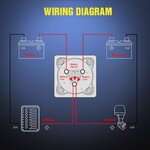BrianK
Well-Known Member
- Region
- USA
- City
- NOVA
Question: Did anyone ever mount a second battery on the rear rack of a Bafang mid drive, with a toggle switch to change over from a dead primary battery to the fully charged back up battery?
Obviously each battery would have to be charged separately.
How hard would it be to add one this way?
It would (obviously) double the mileage of the fully charged e bike and might be a DIY option worth exploring.
Obviously each battery would have to be charged separately.
How hard would it be to add one this way?
It would (obviously) double the mileage of the fully charged e bike and might be a DIY option worth exploring.




